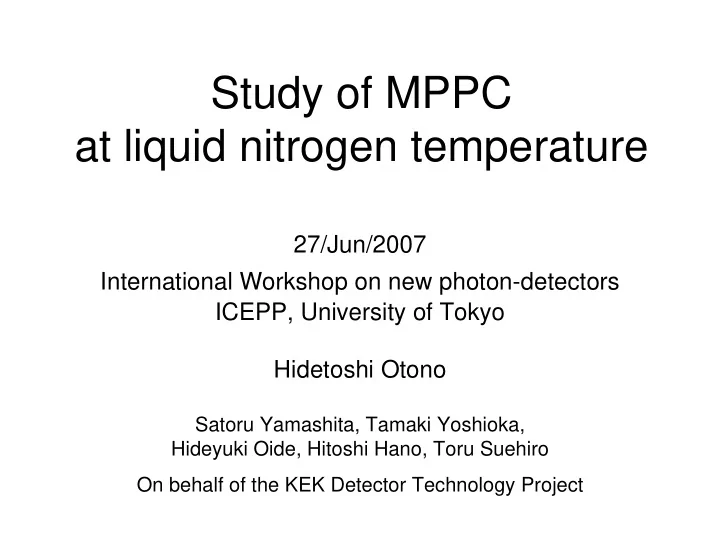

Study of MPPC at liquid nitrogen temperature 27/Jun/2007 International Workshop on new photon-detectors ICEPP, University of Tokyo Hidetoshi Otono Satoru Yamashita, Tamaki Yoshioka, Hideyuki Oide, Hitoshi Hano, Toru Suehiro On behalf of the KEK Detector Technology Project
Introduction • We have measured basic properties of 1600 pix MPPC produced by HPK at low temperatures . • Temperatures - Room Temp. (300K) We directly cooled MPPC. - Ethanol / Dry Ice (200K) - Liquid Nitrogen (77K) • Measured Items - Waveform, - Quenching Resistance, - Pixel Capacitance, - Breakdown Voltage, - Noise Rate, LiN or Ethanol / Dry ice -Voltage [V] - Cross-talk, AMP - After-pulse
Pulse shape • Fast/Slow components are clearly seen at low temperatures. 300K 200K 77K Slow component Slow component Fast component Fast component
Quenching Resistance • We measured I-V curve by applying forward bias . We evaluated quenching resistance value from the I-V curve. IV curve Resistance@ current=10mA Current [mA] 0.21M Ω 300K 10mA 0.40M Ω 200K 1.68M Ω 77K Red 300K Poly-silicon Green 200K Current [mA] +Voltage [V] Blue 77K Forward Bias [V]
Pixel Capacitance • We evaluated pixel capacitance from slope of gain curve. C = − Gain ( Vbias Vbreakdown ) Gain Curve e Gain [10 5 ] Pixel Capacitance 300K 200K 22.1 ± 0.8 fF 300K 77K 22.0 ± 0.7 fF 200K 21.3 ± 0.5 fF 77K Clock ADC MPPC AMP Disc. d ADC Dist.@ Self trigger Bias Voltage [V] ADC Dist.@ Clock trigger
5ns Resistance Capacitance R x C (R) (C) 0.21M Ω 300K 22.1fF 4.6ns 0.40M Ω 200K 22.0fF 8.8ns 300K 1.68M Ω 77K 21.3fF 35.8ns Pulse shape of slow component can be explained by RC time constant 40ns 10ns 200K 77K
Breakdown Voltage • We evaluated breakdown voltage from gain curve. Gain[10 5 ] Breakdown Voltage [V] Bias [V] 300K 200K 50mV / K 77K Temperature [K] • Measured slope (50mV/K) is consistent with the slope observed around room temperature.
Dark Noise • We measured dark noise rate at each temperature. Noise Rate [Hz] 300K Noise Rate 300K 100kHz~1MHz 200K 10Hz~100Hz 200K 77K 1Hz ~ 10Hz 77K Over Voltage [V] : bias voltage – breakdown voltage
Cross-talk • We measured probability that normal pulse generates cross-talk. Probability MPPC AMP Disc.1 Red 300K Scaler Disc.2 Green 200K Blue 77K Disc1 THR for normal pulse Disc2 THR for cross-talk Output Of Disc 2 = Pr ob . Output Of Disc 1 Over Voltage [V] Cross-talk probability is slightly reduced at low temperature.
After-pulse Original pulse We obtained re-emission time constant Re-emitted by measuring time interval between after pulse two pulses (=T). T Entries of distribution Distribution of time interval After-pulse Fit known Accidental Noise = − + − t t P ( t ) A exp( ) B exp( ) τ τ noise emission After-pulse τ emission T [ns] [ns] τ emission 77K 200K 41.8 ± 2.2[ns] 300K 95.6 ± 7.9[ns] 200K 300K These plots are taken 107.6 ± 4.6[ns] 77K at different applied voltage Bias Voltage [V]
Recovery at 77K [mV] [ns] By looking at the pulse shape at 77K, we observed recovery of pulse height after the first pulse. Detailed analysis of this recovery at room temperature will be reported by next speaker.
Summary (1) • We have studied the MPPC basic properties at low temperature. – Waveform Fast/Slow components are seen at low temperature. Pulse shape of slow component can be explained by RC constant. – Quenching Resistance and Pixel Capacitance 300K : 0.21M Ω , 22.1fF 200K : 0.40M Ω , 22.0fF 77K : 1.68M Ω , 21.3fF – Breakdown Voltage Measured slope (50mV/K) is consistent with the slope observed around room temperature.
Summary (2) - Dark Noise 300K : 100kHz ~ 1MHz 200K : 10Hz ~ 100Hz 77K : 1Hz ~ 10 Hz - Cross-talk Cross-talk probability is slightly reduced at low temperature. - Re-emission time constant of After-pulse 300K : 41.8 ± 2.2[ns] 200K : 95.6 ± 7.9[ns] 77K : 107.6 ± 4.6[ns] •Prospects – Measure quantum efficiency at low temperature. – Measure individual difference.
backup
Introduction MPPC and other Geiger-mode APD are expected to be useful at low temperatures for several purpose. • Use w/ liquid inorganic scintillators – LiAr(90K) Our measurement at – LiXe(163K) 300K : Room Temp. • Use in outer space for astrophysics 201K : Ethanol / Dry ice 77K : LiN2 Temp. Ethanol / Dry ice LiN Temp. Room Temp. (201K) (77K) (300K) Outer Space Temp. LiAr Temp. LiXe Temp. (200K~) (90K) (163K)
Probability which after-pulse comes in 50 ns Entries •Normal Noise •Cross-talk known •Accidental Noise •After-pulse Prob = After-pulse/Entries Prob. Red 300K Normal Noise Green 201K Blue 77K Over Voltage [V]
Recommend
More recommend